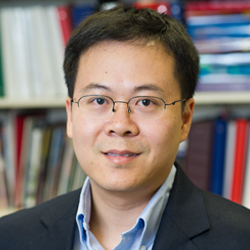
ECS member Jiaxing Huang used freshman-level chemistry to solve the solubility mystery of graphene oxide films.
Image: Northwestern University
Sometimes science can be extremely complex and commanded by technical expertise. But there are moments when one has to go back to his roots to find a more simple answer for a complex issue. That is what ECS member Jiaxing Huang – along with a team of Northwestern University researchers – has done in order to solve the mystery that surrounds the solubility of graphene oxide films.
For years, one question has puzzled the materials science community – why are graphene oxide (GO) films highly stable in water?
When submerged, GO sheets become negatively charged and repel, which should cause membrane to disintegrate. Though much to the confusion of the scientific community, when GO sheets are submerged they stabilize.
This from Northwestern University:
After studying the material for many years, Huang realized that the secret of GO’s mysterious insolubility was the unintentional introduction of a common contaminant. To make a GO film, many scientists pass the acidic dispersion of individual sheets through porous anodized aluminum oxide filter discs, which are popularly used for preparing membranes of many nanomaterials. Huang’s team found that during filtration, the aluminum filter discs corrode in acidic water to release a significant number of aluminum ions, Al3+. The positively charged ion bonds with the negatively charged GO sheets to stabilize the resulting membranes.
“We have solved the puzzle using essentially freshman-level inorganic chemistry,” said Huang. “Now we know that graphene oxide films are indeed soluble in water. It’s just a matter of sample purity.”
You can read Huang’s research in his article, “On the origin of stability of graphene-oxide membranes in water,” published in the journal Nature Chemistry.
Join Huang and other brilliant scientific minds by becoming a member of ECS today!
You can read more of Huang’s work on GO films, including his article entitled “New Faces of Graphene Oxide: 2D Soft Material and Nanofluidic Channels,” in ECS’s Digital Library.


